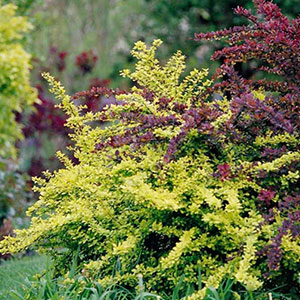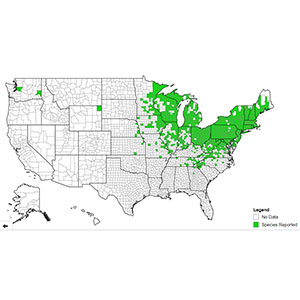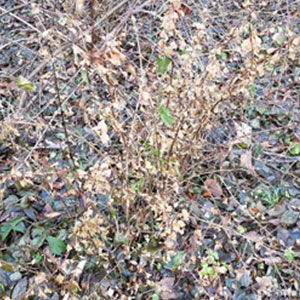A Life Lesson
By Trish Beckjord
As we reach December and the holiday season, I always want to write of health, joy, love and hope. And I wish each and every one of you all of those things for these past months and for 2020.
But I find my thoughts turning this month to a recent article from the University of Exeter published in Nature Communications. It’s titled “Breakthrough in battle against invasive plants.” What the article reports makes such sense to me, I’m surprised it hasn’t been reported before; that the “invasiveness” potential of plant species introduced in the U.S. from Europe and Asia is connected to their innate ability to survive/recover in their native habitat after disturbance.
The concluding recommendation to horticulturalists and other plant enthusiasts that are constantly on the hunt for new plants and new introductions is to stay away from importing plants (and their close relatives) that grow well in disturbed environments.
Of course, this characteristic is exactly one that has made them attractive to commercial development. With few exceptions, as consumers we have always wanted plants that we can put in the ground and walk away from, grow successfully with no work, no careful nurturing or caring on our part. And give me plants with big, showy flowers that bloom a long time and produce lots of attractive fruit!
As I think of this, I’m reminded of a comment in my 1990 4th edition of Manual of Woody Landscape Plants by Michael Dirr, my early reference bible for all things plants.
At the time, Dirr wrote the following about Japanese Barberry (Berberis thunbergii) which is now documented as invasive in the Chicago region’s natural areas: “… Bright red…berry, October persisting into winter; excellent winter effect and should be considered more often for its fruits…” It didn’t hurt that it was also described as “…extremely adaptable… tolerates urban conditions better than many shrubs…” and “…little troubled under ordinary landscape conditions…” Why in the world would I not want to plant this plant?
Barberry is a woody shrub species introduced from Japan. My 1996 Garden Club of America Plants That Merit Attention, Volume II, Shrubs notes that it received the RHS Award of Garden Merit. It is now known as a noxious weed that is invasive in a wide number of states. Over the years, growers have created many cultivars, particularly dwarfed and purple-leaved, a number of which are still popular today. In fact Monrovia, a major grower in the U.S. horticultural market, has a blog post where mention of its invasive risk is only a small footnote at the end of the post. Perhaps this is fair. In looking at the national invasive map for this species, Barberry is mostly problematic in the northeast and Great Lakes regions.
I thought of this again about a week ago as I walked through a small local woodland on a monitoring visit. These must be done annually on conservation easement properties to confirm that the restrictions of the easement are being followed. A small section was an absolutely lovely oak woodland. Stewards and the village had been active in clearing this area and it showed.
But to get there, I walked through what was probably an old field that had been allowed to grow up over time. I must say I had never seen so many invasive introduced woody species in one place before. Honeysuckle predominated (Lonicera tartarica), but there was also Barberry (Berberis thunbergii), Burning Bush (Euonymous alatus), Oriental Bittersweet (Celastrus orbiculatus), and Common Buckthorn (Rhamnus cathartica).
Now, I’m not sharing this to slam the holders of the conservation easement or those who are working to steward it. Time, labor, money, and even interest is always in short supply for this work. And most horticulturalists and growers are now well aware of these problems and working to be more responsible in the plant selections they bring to market.
No, I write this as a cautionary tale to those of us who buy plants. We have to be more responsible in our choices and expectations. We have to appreciate that our planting decisions can have long term effects – and at some distance from our own gardens – both in space and time. We have to think beyond leaf color, flower size, showy fruit production and fast, reliable growth in any condition. We have to understand the links (or lack thereof) between our native insects and birds and plants introduced from other countries.
We have so many beautiful native plants; trees, shrubs, wildflowers and grasses that grow well in these their natural conditions! And they can be used to create beautiful, life-giving gardens. Our life lesson is that when we plant a plant in our yard or on our corporate or college campus, we are the stone that causes the ripple in the pond.
My closing wish for all of you this holiday season is that the ripple you create by your actions is a positive one, not only to yourself but to the larger world.
Blessed be.


This is a photo from the purple-leaved parent Berberis thunbergii var atropurpurea. 
There are now, 14,705 reportings of Barberry in natural areas in the U.S. 
An example of a well-stewarded oak woodland. Photo: T. Beckjord 
In contrast, this section has not been managed. While the overstory trees are not oaks, honeysuckle and other invasive woody species predominate as well as the Dames Rocket (Hesperis matronalis) that is clearly visible along the leading edge of the path. Photo: T. Beckjord 
Amur Honeysuckle (Lonicera maackii) is a non-native honeysuckle species that is a well-known invasive shrub in NE Illinois woodlands. This image, which shows the arching character of the branches, is of a younger plant. The bark on older plants becomes deeply furrowed. Stems are hollow. Photo: T. Beckjord 
In a woodland setting, Japanese Barberry looks innocuous enough to the uneducated eye. The purple-leaf form has less color in the shade and seedlings are often closer in genetics to greener-leaved parents. Photo: T. Beckjord 
Although not showing the bright red fall color that it is planted for, Burning Bush (Euonymous alatus) is another woodland invasive species. This image shows the “horizontal, spreading, flat-topped crown” that led Dirr to describe it in 1990 as “extremely effective in the winter landscape.” Photo: T. Beckjord 
Burning Bush is overused in the landscape and usually heavily over-pruned as in this example which destroys it’s normal branch structure. Photo: T. Beckjord 
Both Oriental and American Bittersweet (Celastrus orbiculatus, Celastrus scandens respectively) are twining vines capable of strangling their climbing support, in this case a young black cherry. They climb to 30-60 feet in the canopy. Flowers and fruit of American Bittersweet grow in terminal clusters whereas the fruit of oriental bittersweet grows from the leaf axils the length of the stem. Photo: T. Beckjord 
May you create a positive ripple! Photo bySnappy ShuttersonUnsplash
Resources
Nature Communications. Breakthrough in battle against invasive plants (2019, December 6)
Penn State News. Native forest plants rebound when invasive shrubs are removed
My thanks to the Chicago Living Corridor Alliance (@chicagoarealivingcorridoralliance) for posting these links!
The Invasive Plant Atlas of the United States
Invasive Plants in the Chicago Region. The Chicago Botanic Garden
Back To Blog
